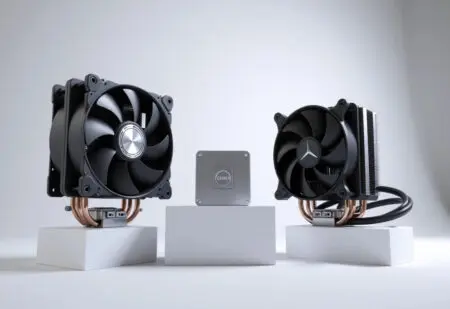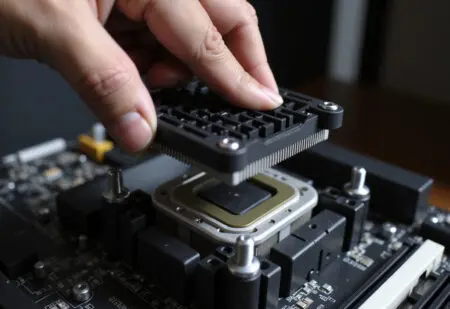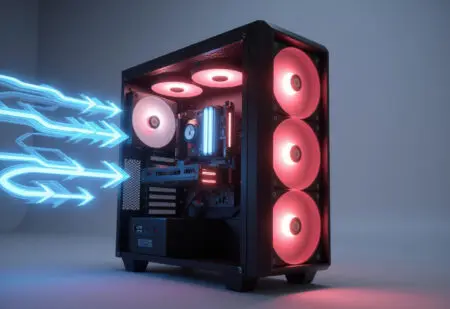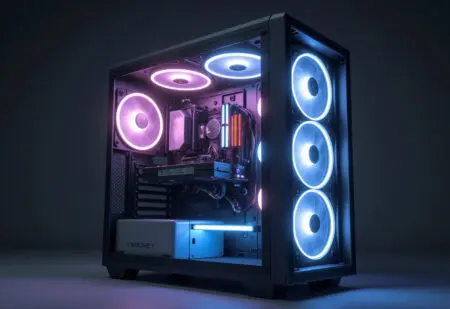For years, a single question has echoed through forums, sparked heated debates in comment sections, and stumped countless PC builders staring at their shopping carts: Is AMD or Intel better for gaming? The truth is, the answer isn’t a simple one-word knockout. It’s more like a championship boxing match, where the title belt gets passed back and forth with each new generation of hardware. One year, one team lands a killer blow with a new technology, and the next, the other team comes back swinging with an architectural marvel.
I’ve been building my own gaming rigs for well over a decade, and I remember the days when the answer was much clearer. You either went with one, or you went with the other, and that was that. But today, in 2025, the competition is fiercer and more nuanced than ever before. Choosing the right CPU isn’t just about picking Team Red or Team Blue; it’s about understanding what you, as a gamer, truly need from the heart of your machine. Are you a competitive esports player chasing every last frame, or a content creator who games and streams from the same PC? The right choice hinges on these personal details.
This guide will cut through the noise. We’re going to break down what actually matters for gaming performance, look at where both AMD and Intel currently stand, and help you figure out which processor is the right co-pilot for your graphics card.
More in CPUs & Processors Category
Is Ryzen 7 5700X Good for Gaming
Is Ryzen 7 5800X Good for Gaming
What Truly Influences a CPU’s Gaming Performance?
Before we can crown a winner, we need to understand the rules of the game. A CPU’s spec sheet is filled with numbers and jargon, but only a few key factors genuinely impact the frame rates you see on screen. It’s easy to get lost in the marketing, but let’s focus on what makes a real-world difference.
Does Clock Speed Still Reign Supreme?
Clock speed, measured in gigahertz (GHz), is essentially how many cycles a CPU can execute per second. For a long time, higher clock speeds directly translated to better gaming performance. I still remember the excitement of overclocking my first processor, pushing it past its limits just to see that GHz number climb, thinking it was the ultimate key to victory.
And to a degree, it still matters. Many games still rely heavily on the performance of a single core to run their main processes. A CPU with a higher clock speed can process those instructions faster, which can lead to smoother gameplay and higher frame rates, especially in older titles or esports games that aren’t optimized for many cores.
However, it’s only part of the story. Modern CPU architecture is far more complex. The “Instructions Per Clock” (IPC) is just as important—it’s a measure of how much work a CPU core can do in a single cycle. Therefore, a newer CPU with a lower clock speed can easily outperform an older one with a higher clock speed simply because it’s more efficient. Think of it like two workers; one is faster, but the other can carry more in a single trip. Sometimes, efficiency beats raw speed.
How Many Cores and Threads Do You Actually Need for Gaming in 2025?
If clock speed is the speed of a worker, then cores are the number of workers you have. Threads are like virtual workers, allowing a single physical core to handle two tasks at once. For years, games barely used more than two or four cores. Today, that has changed significantly.
Modern game engines and APIs like DirectX 12 and Vulkan are much better at spreading the workload across multiple cores. While you won’t see a game using all 16 cores of a high-end CPU, having a solid number of them is crucial for a smooth experience, especially if you’re doing anything else while gaming.
So, what’s the sweet spot?
- 6 Cores / 12 Threads: This is widely considered the baseline for a great modern gaming PC. It provides enough power to handle almost any game without bottlenecking your GPU, leaving some headroom for background tasks like Discord or a browser.
- 8 Cores / 16 Threads: This is the current sweet spot for high-end gaming and future-proofing. It ensures that your CPU will not be a limiting factor for years to come and provides a significant boost if you stream, record, or run other heavy applications while playing.
- 10+ Cores: For pure gaming, anything beyond 8 cores often shows diminishing returns. The performance increase is minimal for the significant price jump. These CPUs are primarily for content creators and professionals who need a workstation that can also game.
What is Cache and Why Should Gamers Care So Much?
CPU cache is a small, incredibly fast bank of memory located directly on the processor chip. It stores frequently used data so the CPU doesn’t have to wait for the much slower system RAM to fetch it. Think of it as a chef’s personal prep station. Instead of running to the main pantry (your RAM) for every ingredient, the most common ones are kept right on the counter (the cache), ready to be used instantly.
The most important type for gaming is the Level 3 (L3) cache. A larger L3 cache can dramatically improve gaming performance because game data, like character positions and world information, can be stored and accessed almost instantaneously. This reduces latency and helps deliver higher and more stable frame rates.
Recently, AMD revolutionized this concept with their 3D V-Cache technology, which involves stacking an enormous amount of L3 cache vertically on top of the processor. The first time I saw benchmarks for a CPU with this technology, I was skeptical. Then I tried one. The difference in certain games was not just noticeable; it was a complete game-changer, proving that raw speed and core counts aren’t the only paths to gaming supremacy.
AMD vs. Intel: Who is Currently Winning the Gaming Crown?
Now that we understand the metrics, let’s get to the main event. In the current market, both AMD and Intel have incredibly compelling options, but they excel in different areas. The best choice for you depends entirely on your priorities and budget.
For the Ultimate, No-Compromise Gaming Performance, Who Should You Choose?
If your sole priority is squeezing every possible frame out of your games, and budget is not your primary concern, the answer right now is clear: AMD.
AMD’s processors featuring their 3D V-Cache technology, like the Ryzen 7 7800X3D, are the undisputed kings of pure gaming. The massive L3 cache on these chips gives them a significant advantage in a wide variety of titles, often allowing them to outperform even the most expensive flagship CPUs from both companies. They achieve this performance while being remarkably power-efficient, meaning they run cooler and quieter. I tried this myself after upgrading a friend’s PC, and the results were stunning. In a simulation-heavy game we both play, his frame rate stability improved so much that it felt like he had upgraded his GPU, not his CPU.
These chips are particularly dominant in games that are CPU-bound and benefit from low-latency data access. Some examples include:
- Factorio
- Microsoft Flight Simulator
- Tarkov
- Starcraft II
- Many MMOs and strategy games
What if You Need a PC for More Than Just Gaming?
This is where Intel makes a powerful counter-argument. If you are a streamer, a video editor, or someone who constantly multitasks with heavy applications running in the background, Intel’s high-end Core i7 and i9 processors are often the better all-around choice.
Intel’s modern architecture utilizes a hybrid design, combining powerful “Performance-cores” (P-cores) for demanding tasks like gaming with smaller, power-efficient “Efficient-cores” (E-cores) for background processes. This allows the CPU to intelligently delegate tasks. For instance, the P-cores can be dedicated to your game while the E-cores handle your streaming software, Discord, and other apps, preventing performance dips.
I run a dual-monitor setup and I’m constantly alt-tabbing, running videos, and keeping multiple applications open. My current rig is built around an Intel CPU precisely for this reason. It handles the chaotic workload of gaming, browsing, and light content creation simultaneously without breaking a sweat. While it might not hit the absolute peak frame rates of an AMD X3D chip in every single game, its incredible versatility and raw multi-threaded power make it a productivity beast.
Are You on a Tighter Budget? Who Offers More Bang for Your Buck?
The budget and mid-range market is where the battle is most intense, and the “best value” crown can change hands overnight depending on sales and new releases. Both AMD and Intel offer fantastic options here.
Historically, AMD’s Ryzen 5 series has been the champion of value, offering strong gaming and multi-core performance at an accessible price. The longevity of their AM4 platform meant you could build a budget PC and have an upgrade path for years.
However, Intel’s Core i5 series, particularly the “K” models that can be overclocked and the more budget-friendly non-K versions, are extremely competitive. They often deliver fantastic gaming performance that punches well above their price class. My advice here is to be pragmatic. Don’t get locked into brand loyalty. Check current prices and benchmarks for the week you plan to buy. Often, the best choice is simply whichever comparable chip from either team is on sale.
Don’t Forget the Bigger Picture: Platforms and Motherboards
Choosing a CPU is a bigger commitment than it seems because it locks you into a specific motherboard platform. This decision affects your future upgrade options, memory choices, and overall build cost.
What is the Deal with AMD’s AM5 and Intel’s Sockets?
One of AMD’s most user-friendly policies has been its commitment to platform longevity. For example, their AM4 socket, launched in 2017, supported CPUs released as late as 2022. They have made a similar promise for their current AM5 platform, pledging support through at least 2025. This means if you buy an AM5 motherboard today, you can likely drop in a new, faster CPU in a couple of years without having to rebuild your entire system.
Intel, on the other hand, has historically changed its motherboard socket every two generations. I’ve been burned by this myself. I once invested in a high-end Intel motherboard, only to discover a year later that the next generation of processors required a completely new one. It’s a frustrating experience that makes AMD’s long-term support incredibly appealing for anyone who likes to upgrade incrementally.
Does DDR4 vs. DDR5 Memory Really Matter for Gaming?
The latest CPU generations brought a transition from DDR4 to the newer, faster DDR5 RAM. For a while, Intel had an advantage here because their 12th, 13th, and 14th generation CPUs supported both, allowing builders to save money by pairing a new CPU with cheaper DDR4 RAM and a corresponding motherboard.
AMD’s current AM5 platform, however, is exclusively DDR5. While this meant higher initial build costs when it first launched, the price of DDR5 has fallen dramatically. For any new gaming PC built in late 2025, DDR5 is the clear choice. It offers higher bandwidth and will be the standard for the foreseeable future. The fundamental drive for this constant improvement in hardware is rooted in decades of engineering, a concept often linked to Moore’s Law, which Purdue University’s School of Electrical and Computer Engineering explains is the observation that the number of transistors in an integrated circuit doubles about every two years.
The Final Verdict: How Do You Choose?
As you’ve seen, the answer is, “it depends.” I spent three solid weeks wrestling with this exact decision for my latest build, swapping parts in and out of online shopping carts. In the end, I chose the processor that best fit my hybrid work-and-play style, not just the one with the highest gaming benchmarks.
To make it simple, here is my final recommendation based on your needs:
- You are a pure gamer. Your PC is a temple for gaming and nothing else. You want the highest possible frame rates and the smoothest experience, period.
- Your Winner: AMD. The Ryzen 7000X3D series processors are tailor-made for you. They are the current gaming champions, hands down.
- You are a gamer and a creator. You play the latest titles, but you also stream your gameplay, edit videos, or use your PC for demanding productivity tasks. You need a powerful all-rounder.
- Your Winner: Intel. A high-end Core i7 or i9 will give you fantastic gaming performance combined with unbeatable multi-threaded power for all your other tasks.
- You are a budget-conscious gamer. You want the most performance possible for your money and a smart upgrade path for the future.
- Your Winner: It’s a Toss-Up. Check the current prices. Compare the Intel Core i5 series against the AMD Ryzen 5 series. Look at real-world gaming benchmarks from trusted reviewers and buy the best combo of CPU and motherboard that fits your budget that day.
Ultimately, the rivalry between AMD and Intel is a huge win for us, the gamers. It forces both companies to innovate, push boundaries, and offer more performance for less money year after year. Whichever team you choose, you’re getting an incredible piece of technology that will power amazing gaming experiences.
Frequently Asked Questions – Is AMD or Intel Better for Gaming
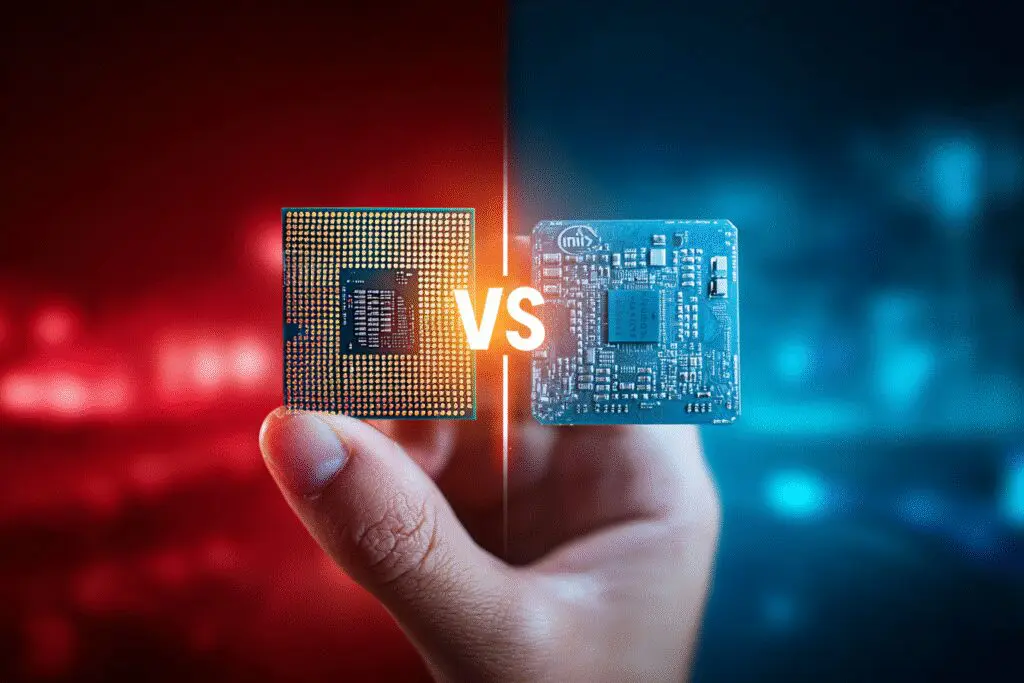
Overall, which brand is better for gaming ?
Both AMD and Intel produce excellent CPUs suitable for gaming, and the choice depends on your specific needs and budget. AMD offers the best gaming speeds and upgrade support, while Intel provides strong multitasking and cost savings with cheaper motherboards.
Which platform is more future-proof for upgrades: AMD or Intel?
AMD’s AM5 platform is more future-proof as it supports long-term socket compatibility, allowing users to upgrade to newer AMD CPUs without changing the motherboard. In contrast, Intel frequently changes socket types, which can require a new motherboard for upgrades.
How do AMD and Intel compare in multitasking and streaming capabilities?
Intel’s latest CPUs use a mix of Performance-cores and Efficient-cores, which improves multitasking and streaming, allowing users to run games while streaming or handling other tasks more effectively. AMD CPUs, while powerful, typically do not have this hybrid core design.
Which CPU brands provide better value for gaming on a budget?
For budget-conscious gamers, AMD’s Ryzen 5 7600 and Intel’s Core i5-13400F are considered top value options because they offer nearly top-tier gaming performance at a much lower price.
What is the main difference between AMD and Intel CPUs for gaming?
The main difference is that AMD’s Ryzen CPUs, especially those with 3D V-Cache technology, tend to offer higher gaming speeds and better performance in many games. Intel CPUs are known for their high clock speeds and strong performance in single-core tasks, making them very competitive for gaming.


